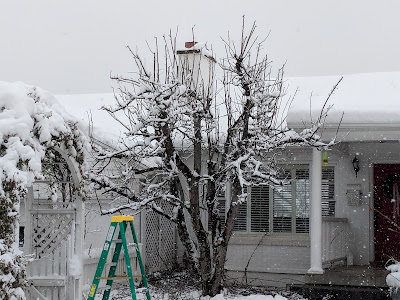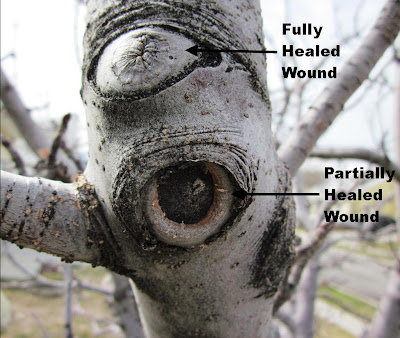Pruning Fruit Trees in the Winter
In this article we will discuss the pros and cons of pruning fruit trees in the winter and help you decide when is the best time to get yours done. Trees can be pruned any time, but you will get different results at different times of the year. Click here for a short overview of the four seasons of pruning fruit trees.
I enjoy writing articles about the care and maintenance of fruit trees, but what I find even more interesting is the polarity of thoughts regarding a subject as inconsequential as fruit tree pruning. Maybe it's just bold anonymity that comes with social media. Your fruit trees will not die if you prune them in the winter. There I said it. Now, lets decide if pruning trees in the winter is a good for your specific trees.
If you would like to learn more about the care and pruning of fruit trees, please subscribe here:
First, where do you live? I spent two years driving in Northern California (USDA Zone 9b). I say driving because I felt like I was commuting to and from work more than I was working and working more than I was living. Winter started mid December and signs of spring appeared in the middle of January. We were lucky to get a few days of frost and it was over. Now I prune backyard fruit trees professionally in Salt Lake City. The hardiness zones in my service area varies from USDA Zone 4 to USDA Zone 6. When trees are in full bloom and my pruning season ends, usually by the end of April, I head north to the mountains of Wyoming. There I manage a small orchard and I still have to wait a few weeks until the snow melts enough to start pruning. The point is, winter looks different in different parts of the world and pruning is not something that can be put on a calendar. You definitely can't make blanket statements like, "fruit tree pruning should be done before Valentines day". That February 14th date might be too early for some and too late for others.
This article discusses when is the best time to prune fruit trees.
When I managed a produce department in a grocery store the joke was, "Don't order too much, don't order too little". Too much and it would go bad before it sold, too little and you would inevitable ruin some stressed out dinner host because he doesn't have the right ingredient for some special recipe that is absolutely critical for the success of his party. The problem was, it's impossible to estimate the demand for produce from one day to another. Same goes with pruning. Don't do it too early, don't do it too late. But what if you run out of 5 lb bags of red potatoes? You can buy a 10 lb bag, or fill a bag of loose potatoes. What if you can't prune your trees in that optimal pruning window? What if you're like me and have thousands of trees to prune every year? What if you are bored out of your mind watching the snow fall and you can't be away from your garden for three months? Get your pruning done!
What are the repercussions of pruning fruit trees too early? Not much really. Lets talk about some fruit tree biology. Trees are still alive in the winter. They are not actively growing, thus the term dormant. They are still breathing, feeding on stored sugars, and transporting water from the roots to the tips. All of theses things are happening within the protection of the bark tissue. What happens when a deer nibbles off some branches? What happens when heavy snow loads break a branch? Will your tree die!? No, that's ridiculous. Well, what if you make a pruning cut? What if you make a hundred pruning cuts? Your tree will wake up and start growing again, it will bloom, set fruit, and all will be well. So what's the big deal? Well, something did happen when when you made pruning cuts in the winter.
Trees don't just scab up and magically heal. The branch collar grows around pruning cuts, sealing them off from outside influences. The bark tissue has to cover up pruning cuts and it doesn't happen very fast. Look at the growth rings found in the wood. That is about how much a fruit tree can grow in a single season. That is about how much a fruit tree can cover over a pruning cut in a single season. Larger pruning cuts will take longer to seal off than small pruning cuts. If you leave a stub behind when pruning, the tree will have to grow up, over and around that stub to seal it off, but it will likely start rotting before that happens.
Most of the annual growth in a fruit tree occurs at the tips of each branch and at a thin layer between the bark and the wood. The layer between bark and wood is called the cambium. When the cambium layer is no longer protected from the bark, due to pruning or other damage, and is exposed to cold temperatures it will die back to a point deeper in the tree. If pruning is done in the late winter or early spring, when temperatures are warmer, each and every pruning cut that is exposed to the elements will not freeze, and will immediately start to divide and grow around the pruning cuts. Sounds good right? Well, these pruning cuts might also send up several water sprouts from each cut. Water sprouts are good in young fruit trees that are still filling out, especially stone fruit that produce on new, one year old branches, but older mature fruit trees like pears and apples can sometimes grow so many water sprouts that they shade out the spurs on mature wood and the tree is forced to abort fruit because it can't get the energy it needs to ripen the fruit on the interior of the tree.
So lets conclude by reviewing the pros and cons of pruning fruit trees in the winter. Pruning fruit trees in the middle of the winter will cause some damage to fruit trees, especially if you live in really cold climates. This damage will slow down the healing process of your tree which could make it more susceptible to fruit tree pests in the summer, but your trees wont die. One of the benefits to winter pruning is fewer water sprouts, but some fruit trees need lots of water sprouts. So when should you prune fruit trees in the winter? I know this is still not really clear, so let me simplify these concepts.
If you live in extremely cold climates, avoid prune your fruit trees in the winter. If you need to make large cuts on fruit trees, wait until spring. If you have stone fruit and want lots of water sprouts wait until spring. If you live in a mild climate, have large trees that only need maintenance pruning, and want to prevent excessive water sprouts, then winter can be a great time to prune your fruit trees.
If you would like to learn more about the care and pruning of fruit trees, please browse our 100+ fruit tree articles here, join our Backyard Fruit Growers Facebook Group, and take our free Fruit Tree Pruning Course. Also, please subscribe to our Fruit Pruning YouTube Channel.










Comments
Post a Comment